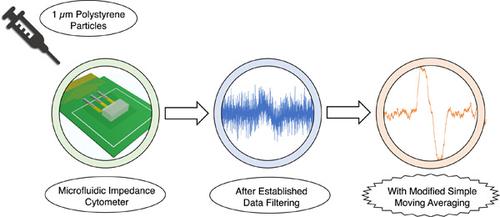当前位置:
X-MOL 学术
›
Biotechnol. Bioeng.
›
论文详情
Our official English website, www.x-mol.net, welcomes your
feedback! (Note: you will need to create a separate account there.)
Time-domain signal averaging to improve microparticles detection and enumeration accuracy in a microfluidic impedance cytometer
Biotechnology and Bioengineering ( IF 3.5 ) Pub Date : 2021-08-09 , DOI: 10.1002/bit.27910 Brandon K Ashley 1 , Umer Hassan 1, 2, 3
Biotechnology and Bioengineering ( IF 3.5 ) Pub Date : 2021-08-09 , DOI: 10.1002/bit.27910 Brandon K Ashley 1 , Umer Hassan 1, 2, 3
Affiliation

|
Microfluidic impedance cytometry is a powerful system to measure micro and nano-sized particles and is routinely used in point-of-care disease diagnostics and other biomedical applications. However, small objects near a sensor's detection limit are plagued with relatively significant background noise and are difficult to identify for every case. While many data processing techniques can be utilized to reduce noise and improve signal quality, frequently they are still inadequate to push sensor detection limits. Here, we report the first demonstration of a novel signal averaging algorithm effective in noise reduction of microfluidic impedance cytometry data, improving enumeration accuracy, and reducing detection limits. Our device uses a 22 µm tall × 100 µm wide (with 30 µm wide focused aperture) microchannel and gold coplanar microelectrodes that generate an electric field, recording bipolar pulses from polystyrene microparticles flowing through the channel. In addition to outlining a modified moving signal averaging technique theoretically and with a model data set, we also performed a compendium of characterization experiments including variations in flow rate, input voltage, and particle size. Multivariate metrics from each experiment are compared including signal amplitude, pulse width, background noise, and signal-to-noise ratio (SNR). Incorporating our technique resulted in improved SNR and counting accuracy across all experiments conducted, and the limit of detection improved from 5 to 1 µm particles without modifying microchannel dimensions. Succeeding this, we envision implementing our modified moving average technique to develop next-generation microfluidic impedance cytometry devices with an expanded dynamic range and improved enumeration accuracy. This can be exceedingly useful for many biomedical applications, such as infectious disease diagnostics where devices may enumerate larger-scale immune cells alongside sub-micron bacterium in the same sample.
中文翻译:

时域信号平均可提高微流控阻抗细胞仪中的微粒检测和计数精度
微流控阻抗细胞术是测量微米和纳米尺寸颗粒的强大系统,通常用于护理点疾病诊断和其他生物医学应用。然而,接近传感器检测极限的小物体会受到相对较大的背景噪声的困扰,并且很难在每种情况下进行识别。虽然许多数据处理技术可用于降低噪声并提高信号质量,但它们通常仍然不足以突破传感器检测极限。在这里,我们报告了一种新颖的信号平均算法的首次演示,该算法可有效降低微流体阻抗细胞计数数据的噪声,提高计数精度并降低检测限。我们的设备使用 22 µm 高 × 100 µm 宽(具有 30 µm 宽聚焦孔径)微通道和金共面微电极,可产生电场,记录流经通道的聚苯乙烯微粒的双极脉冲。除了从理论上和模型数据集概述改进的移动信号平均技术之外,我们还进行了一系列表征实验,包括流量、输入电压和颗粒尺寸的变化。比较每个实验的多变量指标,包括信号幅度、脉冲宽度、背景噪声和信噪比 (SNR)。采用我们的技术可以提高所有实验的信噪比和计数精度,并且在不改变微通道尺寸的情况下将检测限从 5 µm 颗粒提高到 1 µm。继此之后,我们设想实施改进的移动平均技术来开发具有扩展的动态范围和提高的计数精度的下一代微流控阻抗细胞计数设备。 这对于许多生物医学应用非常有用,例如传染病诊断,其中设备可以在同一样本中枚举更大规模的免疫细胞以及亚微米细菌。
更新日期:2021-10-13
中文翻译:

时域信号平均可提高微流控阻抗细胞仪中的微粒检测和计数精度
微流控阻抗细胞术是测量微米和纳米尺寸颗粒的强大系统,通常用于护理点疾病诊断和其他生物医学应用。然而,接近传感器检测极限的小物体会受到相对较大的背景噪声的困扰,并且很难在每种情况下进行识别。虽然许多数据处理技术可用于降低噪声并提高信号质量,但它们通常仍然不足以突破传感器检测极限。在这里,我们报告了一种新颖的信号平均算法的首次演示,该算法可有效降低微流体阻抗细胞计数数据的噪声,提高计数精度并降低检测限。我们的设备使用 22 µm 高 × 100 µm 宽(具有 30 µm 宽聚焦孔径)微通道和金共面微电极,可产生电场,记录流经通道的聚苯乙烯微粒的双极脉冲。除了从理论上和模型数据集概述改进的移动信号平均技术之外,我们还进行了一系列表征实验,包括流量、输入电压和颗粒尺寸的变化。比较每个实验的多变量指标,包括信号幅度、脉冲宽度、背景噪声和信噪比 (SNR)。采用我们的技术可以提高所有实验的信噪比和计数精度,并且在不改变微通道尺寸的情况下将检测限从 5 µm 颗粒提高到 1 µm。继此之后,我们设想实施改进的移动平均技术来开发具有扩展的动态范围和提高的计数精度的下一代微流控阻抗细胞计数设备。 这对于许多生物医学应用非常有用,例如传染病诊断,其中设备可以在同一样本中枚举更大规模的免疫细胞以及亚微米细菌。











































 京公网安备 11010802027423号
京公网安备 11010802027423号